E&RTS 2009 Field Trials
|
CSCI P545
Embedded & Real-Time Computing
|
Thu Sep 24 12:57:06 EDT 2009
[SDJ]
|
|
|
|
dec 11 2009
12:00 hrs
| GO
|
Friday:
Caleb says he will take ERTS to the test field at 13:30 today.
|
[NWS]
|
P545 Project Field Trials
The Computer Science
Embedded & Real-Time Systems course
will hold field trials demonstrating this year's class project,
autonomous GPS navigation with obstacle avoidance,
for a computer controlled vehicle.
Anyone interested in observing the trials, learning about the vehicle,
or the subject of embedded systems is encouraged to observe and
speak with the participants.
| What:
| Demonstrations of autonmous navigation.
The E&RT course laboratory is a golf car modified for computer control.
This semester's project assignment is implementing autonmous navigation
based on the Global Positioning System (GPS), in the presence of
simple obstacles. Additional individual projects in implementing a vision
system may be demonstrated.
|
| When:
| Monday, December 7, 1:00PM, conditions permitting.
Trials are expected to last about three hours.
If conditions do not permit testing on this date, alternate dates are
Tuesday, December 8 at 1:00PM and Wednesday, December 9 at
1:00PM.
Watch [HERE] for status and forecast information.
|
| Where:
| The parking area North of Assembly Hall on Fee Lane.
[MAP]
|
| Presentation:
|
A presentation describing ERTS and the trials is scheduled
for Monday, December 7, 11:45AM, in Lindley Hall 101.
|
|

Photo by Hillary Demmon
|
About the Trials
|
ERTS is a computer controlled golf car supporting research and
instruction in the School of Informatics. Development of its
systems for navigation and control is an ongoing project in the
P545 course.
ERTS's sensory array includes
The field trials have the following components:
-
A trial consists of three laps around a GPS course provided at
initialization.
-
As ERTS traverses the course, it will encounter a number of immobile
obstacles. A trial fails if ERTS hits any of these obstacles.
-
A good NAV will ``plan ahead'' to maneuver in an economical way.
On successive laps, NAV would be able to anticipate obstacles it
has already seen and improve its path around them.
Evaluation Criteria (in decreasing order of importance):
- Completing three labs around the GPS course. The trial fails
unless three full laps are completed.
- Successfully avoiding all obstacles. A penalty
is assesed for each obstacle ERTS strikes.
- Staying within the course boundaries. If
ERTS strays beyond the prescribed course boundaries (see below)
a penalty proportional to the severity (time and distance) is assessed.
- Elapsed time. The faster the better.
- Path planning. NAV should show evidence of anticipation in tight maneuvers.
- Learning. Successive laps should show improved path planning around turns and obstacles.
- Stopping. A bonus is awarded if ERTS stops entirely within the final waypoint.
|
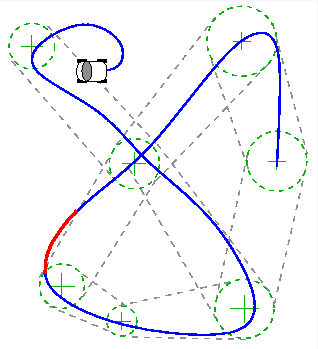
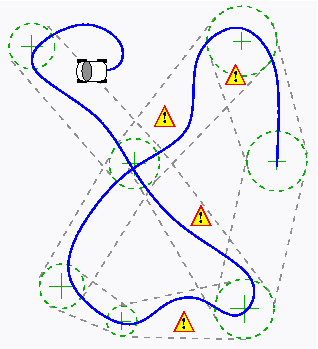
|
What You Will See
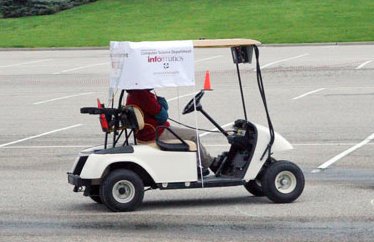 For safety, ERTS always has a Test Driver seated behind the
steering wheel.
The Test Driver can abort a trial and override computer control
should conditions require it. Otherwise, the Test Driver
does not touch the steering wheel, brake pedal, or accellerator
once the trial has started.
For safety, ERTS always has a Test Driver seated behind the
steering wheel.
The Test Driver can abort a trial and override computer control
should conditions require it. Otherwise, the Test Driver
does not touch the steering wheel, brake pedal, or accellerator
once the trial has started.
Each Experimenter in turn will perform their first trial. Once all
systems have been tested, additional trials are done in a first-come
first-served basis.
Trials
- Exprimenters load and start their navigation (NAV) systems on ERTS's
on-board computer network, then leave the vehicle.
- During initialization, NAV reads a list of GPS waypoints that define
the trial's course.
- The Test Driver releases ERTS for computer control.
- A trial consists of three laps through the course. On the first lap,
NAV traverses the course encountering obstacles along the way. It
must steer ERTS around these obstacles as it moves between waypoints.
- On the second and third laps, NAV knows the positions of obstacles
it has seen. Thus, it can now do some advance planning, enabling
it to traverse the course more efficiently and faster.
- NAV should try to coast ERTS to a stop within the final waypoint
(no brakes).
About ERTS
 The E&RT laboratory is a golf car modified for computer control.
The initial instructional implementation was developed by members
of the Computer Science Department's Faculty and Technical Staff.
As they are learning learning embedded-system concepts and design methods,
E&RT students are assigned to solve guidance problems such as GPS navigation
and obstacle avoidence.
The E&RT laboratory is a golf car modified for computer control.
The initial instructional implementation was developed by members
of the Computer Science Department's Faculty and Technical Staff.
As they are learning learning embedded-system concepts and design methods,
E&RT students are assigned to solve guidance problems such as GPS navigation
and obstacle avoidence.
As higher functionality develops over time, the E&RT lab vehicle is
targetted for future research in two primary areas:
- Embedded Systems Research. Principles, methods, and tools advancing
the practice for systems containing purpose-specific software. This broad
range of applications includes robots, vehicles, ``smart'' appliances,
hand-held communications and media devices, to name just a few.
- Situated Intelligence and Learning. Intelligent systems are expected
to function in ever more more sophisticated ways, adapt to changing conditions,
and even learning how to perform better. Development is aimed at
providing a flexible platform for experimental research in artificial intelligence,
computer cognition, and on-the-fly adaptation.
About GPS Navigation
 The Global Positioning System is an array of low-orbit satellites
broadcasting positioning information world-wide. A GPS sensor is
a device that calculates its lattitude, longitude, and altitude
by ``triangulating'' signals from some of these satellites.
The Global Positioning System is an array of low-orbit satellites
broadcasting positioning information world-wide. A GPS sensor is
a device that calculates its lattitude, longitude, and altitude
by ``triangulating'' signals from some of these satellites.
A course is a list of GPS waypoints, containing a target
postion, and an accuracy radius (how close is close enough).
The navigation problem is to steer the vehicle through these
waypoints in the order given by the course.
The vehicle Navigator (NAV) is a program that samples the GPS
sensor at regular intervals and adjusts the vehicle's heading
and speed to guide it through the waypoints.
|
The Corridor
 The course boundary is defined by lines connecting the waypoints as
illustrated to the right. A vehicle is not required to "hit"
the waypoint's GPS coordinates but rather to stay within
this course "corridor."
The course boundary is defined by lines connecting the waypoints as
illustrated to the right. A vehicle is not required to "hit"
the waypoint's GPS coordinates but rather to stay within
this course "corridor."
|
Path Planning
 Like a human would, better navigation
software will perform maneuvers that anticipate the pattern of waypoints
that lie ahead. For example, it might swing a bit to the right in
anticipation of a sharp left turn, or slow down when approaching
an S-curve. The vehicle path shown here is an illustration of
poor planning; although the vehicle passes close to each
waypoint, an ``intelligent'' navigator would plan a more
elegant path through the course.
Like a human would, better navigation
software will perform maneuvers that anticipate the pattern of waypoints
that lie ahead. For example, it might swing a bit to the right in
anticipation of a sharp left turn, or slow down when approaching
an S-curve. The vehicle path shown here is an illustration of
poor planning; although the vehicle passes close to each
waypoint, an ``intelligent'' navigator would plan a more
elegant path through the course.
|
About Obstacle Avoidance
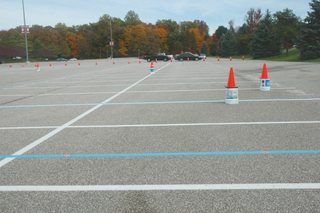 ERTS's obstacle sensor is a Laser Detection and Ranging (LADAR)
device that sweeps a laser beam from side to side, measuring the
reflection time to estimate a distance to the reflecting object.
From this and other information, NAV computes the bearing of the
obstacle, initiating a steering action if necessary to avoid it.
ERTS's obstacle sensor is a Laser Detection and Ranging (LADAR)
device that sweeps a laser beam from side to side, measuring the
reflection time to estimate a distance to the reflecting object.
From this and other information, NAV computes the bearing of the
obstacle, initiating a steering action if necessary to avoid it.
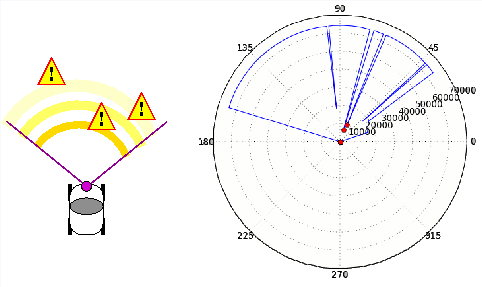
|
© Steven D. Johnson and The Indiana University Trustees



 For safety, ERTS always has a Test Driver seated behind the
steering wheel.
The Test Driver can abort a trial and override computer control
should conditions require it. Otherwise, the Test Driver
does not touch the steering wheel, brake pedal, or accellerator
once the trial has started.
For safety, ERTS always has a Test Driver seated behind the
steering wheel.
The Test Driver can abort a trial and override computer control
should conditions require it. Otherwise, the Test Driver
does not touch the steering wheel, brake pedal, or accellerator
once the trial has started.
 The E&RT laboratory is a golf car modified for computer control.
The initial instructional implementation was developed by members
of the Computer Science Department's Faculty and Technical Staff.
As they are learning learning embedded-system concepts and design methods,
E&RT students are assigned to solve guidance problems such as GPS navigation
and obstacle avoidence.
The E&RT laboratory is a golf car modified for computer control.
The initial instructional implementation was developed by members
of the Computer Science Department's Faculty and Technical Staff.
As they are learning learning embedded-system concepts and design methods,
E&RT students are assigned to solve guidance problems such as GPS navigation
and obstacle avoidence.




